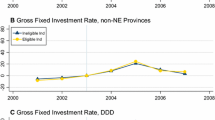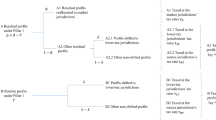Abstract
China’s new Corporate Income Tax Law was passed in March 2007 and took effect on January 1 2008. It terminates the dual corporate income tax regime by removing the preferential tax treatments offered to foreign investment enterprises (FIEs) and unifies the corporate income tax regime for FIEs and Chinese domestic enterprises (DEs). This paper uses a difference-in-differences approach to determine whether FIEs are responding to the law by reducing their investment in China. Employing the Chinese Industrial Enterprises Database (2002∼2008) to implement the analysis, we find that: (1) FIEs are responding to the law by reducing their investment in China; and (2) the magnitude of the response is larger for HongKong-Macau-Taiwan (HMT) investment enterprises than that for other FIEs, which supports the claim that some Chinese investors engaged in “roundtripping” FDI. Our confidence in the conclusions are further boosted by the results of a series of placebo tests and two robustness checks: (1) the results of the placebo tests support the claim that the estimated effect is due to the tax reform rather than to other confounding factors; (2) the results of the first robustness check are consistent with the perception that State-Owned Enterprises (SOEs) might enjoy more favorable treatments from the Chinese government than Private-Owned Enterprises (POEs); and (3) the results of the second robustness check show that incorporating enterprise-specific time trends into the baseline specification of our econometric models does not change the conclusions.


Similar content being viewed by others
Notes
References
Altshuler, R., Grubert, H., & Newlon, T. S. (1998). Has U.S. investment abroad become more sensitive to tax rates. NBER Working Paper No. 6383.
Alworth, J. (1988). The financial decisions of multinationals. Oxford: Blackwell.
Auerbach, A. J., & Hassett, K. (1993). Taxation and foreign direct investment in the united states. In A. Giovannini, R. G. Hubbard, & J. Slemrod (Eds.), Studies in international taxation (pp. 119–144). Chicago: University of Chicago Press.
Bond, S. R., & Cummins, J. G. (2000). The stock market and investment in the new economy: some tangible facts and intangible fictions. Brookings Paper on Economic Activity, 1, 61–108.
Boskin, M., & Gale, W. G. (1987). New results on the effects of tax policy on the international location of investment. In M. Feldstein (Ed.), The effects of taxation on capital accumulation (pp. 201–219). Chicago: University of Chicago Press.
Caves, R. E. (1982). Multinational enterprise and economic analysis. Cambridge: Cambridge University Press.
Coughlin, C. C., Terza, J. V., & Arromdee, V. (1991). State characteristics and the location of foreign direct investment within the United States. Review of Economics and Statistics, 68(4), 675–683.
Desai, M. A., & Goolsbee, A. D. (2004). Investment, overhang, and tax policy. Brookings Paper on Economic Activity, 2, 285–338.
Desai, M. A., Fritz Foley, C., & Hines, J. R. Jr. (2004). Foreign direct investment in a world of multiple taxes. Journal of Public Economics, 88, 2727–2744.
Devereux, M. P., & Freeman, H. (1995). The impact of tax on foreign direct investment: empirical evidence and the implications for tax integration schemes. International Tax and Public Finance, 2, 85–106.
Dharmapala, D., & Hines, J. R. Jr. (2009). Which countries become tax havens?. Journal of Public Economics, 93, 1058–1068.
Dharmapala, D., & Khanna, V. S. (2008). Corporate governance, enforcement and firm value: evidence from India. University of Michigan Olin Law & Economics Working Paper No. 08-005
Edgerton, J. (2010). Investment incentives and corporate tax asymmetries. Journal of Public Economics, 94, 936–952.
Gersovitz, M. (1987). The effects of domestic taxes on foreign private investment. In D. Newbery & N. Stern (Eds.), The theory of taxation for developing countries. New York: Oxford University Press.
Grubert, H., & Mutti, J. (1991). Taxes, tariffs and transfer pricing in multinational corporate decision making. Review of Economics and Statistics, 73(2), 285–293.
Harris, D. G. (1993). The impact of U.S. tax law revision on multinational corporations’ capital location and income-shifting decisions. Journal of Accounting Research, 31, 111–140.
Hartman, D. G. (1984). Tax policy and foreign direct investment in the United States. National Tax Journal, 37(4), 475–487.
Hines, J. R. Jr. (1996). Altered states: taxes and the location of foreign direct investment in America. American Economic Review, 86(5), 1076–1094.
Hines, J. R. Jr. (1997). Tax policy and the activities of multinational corporations. In A. J. Auerbach (Ed.), Fiscal policy: lessons from economic research (pp. 401–445). Cambridge: MIT Press.
Hines, J. R. Jr. (1998). Tax sparing’ and direct investment in developing countries. NBER Working Paper No. 6728.
Hines, J. R. Jr. (1999). Lessons from behavioral responses to international taxation. National Tax Journal, 52(2), 305–322.
Hines, J. R. Jr., & Rice, E. M. (1994). Fiscal paradise: foreign tax havens and American business. Quarterly Journal of Business, 109(1), 149–182.
Newlon, T. S. (1987). Tax policy and the multinational firm’s financial policy and investment decisions. Ph.D. Dissertation, Princeton: Princeton University.
Ondrich, J., & Wasylenko, M. (1993). Foreign direct investment in the United States: issues, magnitudes, and location choice of new manufacturing. Kalamazoo: W.E. Upjohn Institute.
Slemrod, J. (1990). Tax effects on foreign direct investment in the United States: evidence from a cross-country comparison. In A. Razin & J. Slemrod (Eds.), Taxation in the global economy (pp. 79–117). Chicago: University of Chicago Press.
Swenson, D. L. (1994). The impact of U.S. tax reform on foreign direct investment in the United States. Journal of Public Economics, 54(2), 243–266.
Swenson, D. L. (2001). Transaction type and the effect of taxes on the distribution of foreign direct investment in the United States. In J. R. Hines Jr. (Ed.), International taxation and multinational activity (pp. 89–108). Chicago: University of Chicago Press.
United Nations (1994). World investment report 1994: transnational corporations, employment and the workplace. New York: United Nations.
Wooldridge, J. M. (2002). Econometric analysis of cross-section and panel data. Cambridge: MIT Press.
Young, K. H. (1988). The effects of taxes and rates of return on foreign direct investment in the United States. National Tax Journal, 41(1), 109–121.
Acknowledgements
The author thanks Alan J. Auerbach, Emmanuel Saez, Feila Zhang, and the anonymous referee for helpful comments. Especially, the author thanks Dhammika Dharmapala, the editor of this journal, for his constructive suggestions and great patience.
Author information
Authors and Affiliations
Corresponding author
Rights and permissions
About this article
Cite this article
An, Z. Taxation and foreign direct investment (FDI): empirical evidence from a quasi-experiment in China. Int Tax Public Finance 19, 660–676 (2012). https://doi.org/10.1007/s10797-011-9201-0
Published:
Issue Date:
DOI: https://doi.org/10.1007/s10797-011-9201-0
Keywords
- Corporate income tax
- Foreign direct investment (FDI)
- Foreign investment enterprise (FIE)
- Multinational corporation (MNC)




